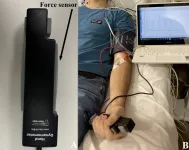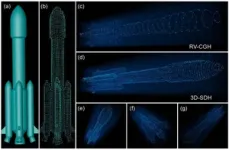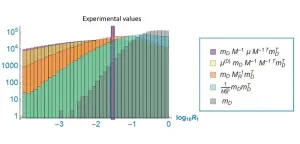(Press-News.org) Studies of consciousness often run into a common conundrum of science—it’s hard to measure a system without the measurement affecting the system. Researchers assessing consciousness, for instance as volunteers receive anesthesia, typically use spoken commands to see if subjects can still respond, but that sound might keep them awake longer or wake them up sooner than normal. A new study not only validates a way to assess consciousness without external stimulation, it also finds that it may be more precise.
“We want to measure when people make the transition from conscious to unconscious, and vice versa, but as soon as you ask someone to do something, which is the classic way of assessing this, you’ve now influenced them and disrupted the process,” said Christian Guay, lead author of the study in the British Journal of Anaesthesia. Guay is a research collaborator at the Neuroscience Statistics Research Laboratory in The Picower Institute for Learning and Memory at MIT, and an anesthesiologist and critical care fellow at Massachusetts General Hospital (MGH). “We think that conscious state transitions are interesting because they are very dynamic in the brain, but the neural mechanisms mediating these transitions aren’t fully understood, in part because of how we are assessing the transitions.”
Moreover, Guay is part of a collaboration with co-authors and former colleagues at Washington University in St. Louis to test whether a method of closed loop acoustic stimulation can augment the effects of dexmedetomidine-mediated sedation. For that reason, too, they needed a method of assessing consciousness that didn’t require sounds that could confound the results.
So the team found a different, little-used approach first described in 2014 by sleep researchers. Before the infusion began, they instructed their 14 volunteers to squeeze a force sensor with their hand whenever they breathed in and release it when they breathed out. Then the drug started flowing. When subjects stopped performing the “breathe-squeeze task,” they were judged to have lost responsiveness and when they resumed after dosing tapered off, they were judged to have regained responsiveness. Importantly, after the initial instruction there was no ongoing external stimulation from the researchers. The task was internally prompted.
All along, the researchers recorded the subjects’ brain rhythms using 64 electrodes around the scalp. They observed telltale patterns of dexmedetomidine effects—for instance a decline in ~10Hz “alpha” rhythm power in the occipital region followed by an increase in power of much slower “delta” waves as people lost responsiveness and then a reversal of that when they woke up. Because of their approach they didn’t see artifacts of auditory stimulation that disrupted those patterns in a previous study that used sound to measure consciousness in people receiving the same anesthetic. Moreover, estimates of drug concentration in the brain during the two studies suggest that the breathe-squeeze method detected loss of responsiveness at lower concentrations of the drug than the sound-stimulation method, suggesting it is more sensitive.
“This approach for assessing loss and recovery of consciousness removes the significant confound of the conventional external stimulus that is typically used,” said study co-senior author Emery N. Brown, Edward Hood Taplin Professor of Medical Engineering and Computational Neuroscience in The Picower Institute at MIT as well as an anesthesiologist at MGH and Warren M. Zapol Professor of Anaesthesia at Harvard Medical School. “We are eager to apply the technique in our studies of other anesthetics.”
At MIT and MGH, Brown is leading a new initiative, the Brain Arousal State Control Innovation Center (BASCIC), to better unify anesthesiology and research into the neuroscience of the brain’s arousal systems so that they can each inform and improve each other, and spawn new clinical innovations. Guay, who is a member of the effort, notes that as researchers achieve a better understanding of the transition from consciousness to unconsciousness, they could help treat insomnia better, and if they understand the process of waking better they might be able to improve the chances of coma reversal. Improving methods of assessing consciousness transitions are key to those efforts.
In addition to Guay and Brown, who is a faculty member in MIT’s Department of Brain and Cognitive Sciences and Institute for Medical Engineering and Science, the study’s other authors are Darren Hight, Guarang Gupta, MohammadMehdi Kafashan, Anhthi Luong, Michael Avidan and Ben Julian Palanca.
Funding for the study came from the McDonnell Center for Systems Neuroscience at Washington University. Brown’s MIT lab is supported in part by The JPB Foundation.
END
Studying consciousness without affecting it
A new study tests an alternative to external stimulation for measuring when subjects lose and regain responsiveness during sedation and anesthesia.
2023-04-06
ELSE PRESS RELEASES FROM THIS DATE:
New pesticide exposure test developed to protect inexperienced cannabis farmers
2023-04-06
A chemical analyst and expert in micro-extraction at The University of Toledo created a more reliable, robust and efficient way to monitor pesticide exposure and help protect the health and safety of agricultural workers, especially for emerging sectors like the cannabis industry.
Dr. Emanuela Gionfriddo, an assistant professor of analytical chemistry, and Nipunika H. Godage, a Ph.D. candidate in UToledo’s Dr. Nina McClelland Laboratory for Water Chemistry and Environmental Analysis, published research in the journal Analytical and Bioanalytical Chemistry outlining their groundbreaking method that is able to detect 79 pesticide residues in human blood plasma ...
Binghamton University receives $9.3 million in federal funding to train school-based mental health professionals
2023-04-06
BINGHAMTON, N.Y. -- Economically disadvantaged students face food scarcity, unreliable access to services and other stressors, which can have a huge impact on their mental health. In Broome and Tioga counties, more than 50% of children live in families characterized as low income. New federal funding will help to put more Binghamton University social work students in schools to provide the services that these students need to succeed.
The U.S. Department of Education has awarded two 5-year awards, totalling $9.3 million, to Binghamton University Community Schools (BUCS) to ...
Non-drug interventions for patients with Alzheimer’s are both effective and cost-effective, study shows
2023-04-06
PROVIDENCE, R.I. [Brown University] — While new drugs to treat Alzheimer’s disease tend to receive the most public attention, many well-researched ways to care for people with dementia don’t involve medication. A new evaluation compared the cost-effectiveness of four non-drug interventions to the usual care received by people with dementia and found that the interventions not only resulted in a better quality of life, but also saved money.
In a study published April 6 in Alzheimer's & Dementia: ...
Moving towards 3 degrees of warming – the phasing out of coal is too slow
2023-04-06
The use of coal power is not decreasing fast enough. The Paris Agreement’s target of a maximum of 2 degrees of warming appear to be missed, and the world is moving towards a temperature increase of 2.5–3 degrees. At the same time it is feasible to avoid higher warming. This is shown by researchers from Chalmers University of Technology and Lund University, Sweden, in a new study.
“More and more countries are promising that they will phase out coal from their energy systems, which is positive. But ...
Newly discovered probiotic could protect Caribbean corals threatened by deadly, devastating disease
2023-04-06
Researchers with the Smithsonian’s National Museum of Natural History have discovered the first effective bacterial probiotic for treating and preventing stony coral tissue loss disease (SCTLD), a mysterious ailment that has devastated Florida’s coral reefs since 2014 and is rapidly spreading throughout the Caribbean.
The probiotic treatment, described in a paper published today in Communications Biology, provides an alternative to the use of the broad-spectrum antibiotic amoxicillin, which has so far been the only proven treatment for the disease but which runs the risk of promoting antibiotic-resistant bacteria.
SCTLD ...
Significant step in fight against drug resistance in TB
2023-04-06
University of Otago researchers have discovered new ways to treat antibiotic-resistant strains of tuberculosis (TB), opening the door to new approaches for tackling the disease that kills about 4,000 people a day.
Led by PhD candidate Natalie Waller and Senior Author Dr Matthew McNeil, of the Department of Microbiology and Immunology, researchers were able to identify antibiotics that could rapidly kill drug resistant strains of TB and when combined could stop drug resistance from occurring altogether.
TB is a major global cause of infectious disease morbidity and mortality, second only to COVID-19 and is one of the hardest infections to treat. ...
Pancreatic lesions may occur more frequently than previously thought
2023-04-06
Bottom Line: Pancreatic intraepithelial neoplasia (PanIN) lesions were detected in a majority of healthy pancreata from deceased donors of diverse age and harbored features of pancreatic cancer.
Journal in Which the Study was Published: Cancer Discovery, a journal of the American Association for Cancer Research
Authors: Marina Pasca di Magliano, PhD, co-corresponding author of the study, a researcher at the Rogel Cancer Center, and a professor of surgery and of cell and developmental biology at Michigan Medicine at the University of Michigan
Timothy Frankel, MD, co-corresponding author, a researcher at the Rogel Cancer Center, and an ...
People with obesity due to genetic predisposition have lower risk of cardiovascular disease
2023-04-06
The risk of developing cardiovascular disease is lower in people with obesity who have a genetic predisposition for high BMI than people with obesity influenced mainly by environmental factors such as lifestyle, researchers from Karolinska Institutet report in eClinicalMedicine.
There has been a global increase in the incidence of overweight and obesity over the past few years. Almost one third of the world’s population now lives with overweight or obesity.
“The figure is alarming since it is well-established that a high BMI in middle-age increases the risk of developing ...
Obstructive sleep apnea may directly cause early cognitive decline
2023-04-06
Obstructive sleep apnea (OSA) is a potentially dangerous condition. During sleep, the throat muscles of people with OSA relax and block the airflow into the lungs, so that they repeatedly stop breathing. Common symptoms of OSA include restless sleep, loud snoring, daytime sleepiness, and prolonged headaches in the morning – highly debilitating for patients and their partners.
OSA is currently underdiagnosed: it may occur in as much as 15 to 30% of men and 10 to 15% of women, or approximately 1bn adults worldwide, of whom an estimated 80% don’t know they have it. Major risk factors for OSA include middle or old age, being obese, smoking, ...
Random matrix theory approaches the mystery of the neutrino mass!
2023-04-06
When any matter is divided into smaller and smaller pieces, eventually all you are left with—when it cannot be divided any further—is a particle. Currently, there are 12 different known elementary particles, which in turn are made up of quarks and leptons each of which come in six different flavors. These flavors are grouped into three generations—each with one charged and one neutral lepton—to form different particles, including the electron, muon, and tau neutrinos. In the Standard Model, the masses of the three generations of neutrinos are represented by a three-by-three ...
LAST 30 PRESS RELEASES:
SIMJ announces global collaborative book project in commemoration of its 75th anniversary
Air pollution exposure and birth weight
Obstructive sleep apnea risk and mental health conditions among older adults
How talking slows eye movements behind the wheel
The Ceramic Society of Japan’s Oxoate Ceramics Research Association launches new international book project
Heart-brain connection: international study reveals the role of the vagus nerve in keeping the heart young
Researchers identify Rb1 as a predictive biomarker for a new therapeutic strategy in some breast cancers
Survey reveals ethical gaps slowing AI adoption in pediatric surgery
Stimulant ADHD medications work differently than thought
AI overestimates how smart people are, according to HSE economists
HSE researchers create genome-wide map of quadruplexes
Scientists boost cell "powerhouses" to burn more calories
Automatic label checking: The missing step in making reliable medical AI
Low daily alcohol intake linked to 50% heightened mouth cancer risk in India
American Meteorological Society announces Rick Spinrad as 2026 President-Elect
Biomass-based carbon capture spotlighted in newly released global climate webinar recording
Illuminating invisible nano pollutants: advanced bioimaging tracks the full journey of emerging nanoscale contaminants in living systems
How does age affect recovery from spinal cord injury?
Novel AI tool offers prognosis for patients with head and neck cancer
Fathers’ microplastic exposure tied to their children’s metabolic problems
Research validates laboratory model for studying high-grade serous ovarian cancer
SIR 2026 delivers transformative breakthroughs in minimally invasive medicine to improve patient care
Stem Cell Reports most downloaded papers of 2025 highlight the breadth and impact of stem cell research
Oxford-led study estimates NHS spends around 3% of its primary and secondary care budget on the health impacts of heat and cold in England
A researcher’s long quest leads to a smart composite breakthrough
Urban wild bees act as “microbial sensors” of city health.
New study finds where you live affects recovery after a hip fracture
Forecasting the impact of fully automated vehicle adoption on US road traffic injuries
Alcohol-related hospitalizations from 2016 to 2022
Semaglutide and hospitalizations in patients with obesity and established cardiovascular disease
[Press-News.org] Studying consciousness without affecting itA new study tests an alternative to external stimulation for measuring when subjects lose and regain responsiveness during sedation and anesthesia.







